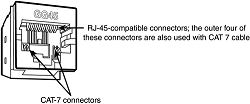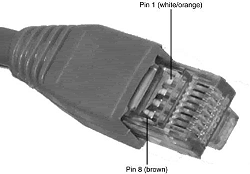Installating Network Cable
If you have to run cables (of any type) through existing walls and ceilings, the cable installation can be the most expensive part of setting up a LAN. At every branching point, special fittings connect the intersecting wires. Sometimes, you also need various additional components along the way, such as hubs, repeaters, or MSAUs.
With the development of easy-to-build (or prebuilt) Category 5 twisted-pair cabling, high-speed and low-cost NICs and hubs, and built-in basic networking in current versions of Windows, installing and setting up a network today is far easier than ever before.
For small cubicle/office networking in which no wire must be routed through walls and in which Windows peer networking software will be used, you should be able to set up the network yourself.
If your wiring must go through walls, be run through dropped ceilings, be piggybacked on air ducts, or be run between floors, you might want to have professional network-cable specialists install the cable.
A good company knows the following:
-
When UTP (unshielded twisted-pair) cabling is adequate
-
Where STP (shielded twisted-pair) cabling might be necessary to avoid excessive cable runs and interference
-
How to route cable between rooms, floors, and nonadjacent offices
-
How to use wall panels to make cable attachments look better and more professional
-
When you must use fireproof Plenum cable
-
How to deal with sources of electrical interference, such as elevator motors, transmitters, alarm systems, and even florescent office lighting, by using fiber-optic or shielded cable
If you decide you need professional cable installation, be sure to get a firm price quote first because the cost of a complex cable installation might make a wireless network a more appealing choice.
Selecting Cable
A network is only as fast as its slowest component; to achieve the maximum speeds of the network, all its components, including cables, must meet the standards. Two standard types of twisted-pair cabling exist:
-
Category 3 cable. The original type of UTP cable used for Ethernet networks was also the same as that used for business telephone wiring. This is known as Category 3, or voice-grade UTP cable, and is measured according to a scale that quantifies the cable's data-transmission capabilities.
The cable itself is 24 AWG (American Wire Gauge, a standard for measuring the diameter of a wire), copper-tinned with solid conductors, 100–105 ohm characteristic impedance, and a minimum of two twists per foot. Category 3 cable is adequate for networks running at up to 16Mbps.
This cable usually looks like "silver" telephone cable, but with the larger RJ-45 connector. Category 3 cabling is obsolete because it doesn't support Fast Ethernet or greater network speeds.
-
Category 5 cable. The newer, faster network types require greater performance levels. Fast Ethernet (100BASE-TX) uses the same two-wire pairs as 10BASE-T, but Fast Ethernet needs a greater resistance to signal crosstalk and attenuation. Therefore, the use of Category 5 UTP cabling is essential with 100BASE-TX Fast Ethernet.
Although the 100BASE-T4 version of Fast Ethernet can use all four-wire pairs of Category 3 cable, this flavor of Fast Ethernet is not widely supported and has practically vanished from the marketplace.
Thus, for practical purposes, if you mix Category 3 and Category 5 cables, you should use only 10BASE-T (10Mbps) Ethernet hubs; if you try to run Fast Ethernet 100BASE-TX over Category 3 cable, you will have a slow and unreliable network. Category 5 cable is commonly called CAT5 and is also referred to as Class D cable.
Many cable vendors also sell an enhanced form of Category 5 cable called Category 5e (specified by Addendum 5 of the ANSI/TIA/EIA-568-A cabling standard). Category 5e cable can be used in place of Category 5 cable and is especially well suited for use in Fast Ethernet networks that might be upgraded to Gigabit Ethernet in the future.
Category 5e cabling must pass several tests not required for Category 5 cabling. Even though you can use both Category 5 and Category 5e cabling on a Gigabit Ethernet network, Category 5e cabling provides better transmission rates and a greater margin of safety for reliable data transmission.
Category 6 cabling (also called CAT 6 or Class E) can be used in place of CAT 5 or 5e cabling and uses the same RJ-45 connectors as CAT 5 and 5e. CAT 6 cable handles a frequency range of 1MHz–250MHz, compared to CAT5 and CAT5e's 1MHz–100MHz frequency range.
You should use existing Category 3 cable for your LAN only if you are content with the 10Mbps speeds of 10BASE-T and if the cable is in good condition. The silver exterior on Category 3 cabling can become brittle and deteriorate, leading to frequent network failures.
If you are installing new wiring for a new network or replacing deteriorated Category 3 cable, you should use Category 5, Category 5e, or Category 6 cabling. All three types are widely available either in prebuilt assemblies or in bulk.
The newest standard—Category 7 cabling (also called CAT 7 or Class F)—handles a frequency range of 1MHz–600MHz and reduces propagation delay and delay skew, which enables longer network cables and larger numbers of workstations on a network. CAT 7 uses the GG45 connector developed by Nexans.
The GG45 connector resembles the RJ-45 connector but has four additional contacts. The GG45 connector contains a switch that activates a maximum of 8 out of 12 contacts. The upper 8 RJ45 contacts are used for up to 250MHz (CAT 6) operation, whereas the 8 contacts in the outer edges are used for 600MHz (CAT 7) operation.
Only 8 contacts are used at a given time. In other words, this connector is designed to be backward-compatible with cables using RJ-45 connectors, while supporting the newer standard.
Choosing the correct type of Category 5/5e cable is also important. Use solid PVC cable for network cables that represent a permanent installation.
However, the slightly more expensive stranded cables are a better choice for a notebook computer or temporary wiring of no more than 10" lengths (from a computer to a wall socket, for example) because it is more flexible and is therefore capable of withstanding frequent movement.
If you plan to use air ducts or suspended ceilings for cable runs, you should use Plenum cable, which doesn't emit harmful fumes in a fire. It is much more expensive, but the safety issue is a worthwhile reason to use it (and it is required by some localities).
Building Twisted-Pair Cables
When it's time to wire your network, you have two choices. You can opt to purchase prebuilt cables, or you can build your own cables from bulk wire and connectors.
You should build your own twisted-pair cables if you:
-
Plan to perform a lot of networking
-
Need cable lengths longer than the lengths you can buy preassembled at typical computer departments
-
Want to create both standard and crossover cables
-
Want to choose your own cable color
-
Want maximum control over cable length
-
Want to save money
-
Have the time necessary to build cables
TP Wiring Standards
If you want to create twisted-pair (TP) cables yourself, be sure your cable pairs match the color-coding of any existing cable or the color-coding of any prebuilt cabling you want to add to your new network.
Because there are eight wires in TP cables, many incorrect combinations are possible. Several standards exist for UTP cabling. One common standard is the AT&T 258A configuration (also called EIA/TIA 568B).

